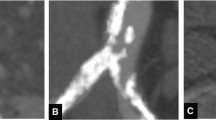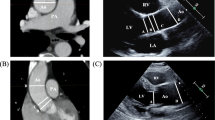Abstract
Purpose
This study was performed to evaluate whether dynamic computed tomography (CT) can provide functional vessel information predicting outcomes of aortic neck in patients undergoing endovascular aneurysm repair (EVAR) of an abdominal aortic aneurysm (AAA).
Materials and methods
Twenty patients with and 20 without AAA were enrolled. Electrocardiographically (ECG)-gated data sets were acquired with a 64-slice CT scanner. Axial pulsatility measurements were taken at three levels: 2 cm above the highest renal artery; immediately below the lowest renal artery; 1 cm below the lowest renal artery. Three independent readers performed the measurements. Systolic and diastolic blood pressures were measured in the brachial artery to calculate arterial-wall distensibility expressed as pressure strain elastic modulus (Ep). Cross-sectional area change, wall distensibility and Ep value were statistically compared.
Results
No significant differences were found in terms of Ep values in the suprarenal and juxtarenal level. In the AAA group, a significantly higher value was obtained at the infrarenal level. A subgroup of patients with AAA (45%) had a significantly higher Ep value at the infrarenal level.
Conclusions
Dynamic CT provided insight into the abdominal aorta pathophysiology. Identifying patients with higher infrarenal distensibility could change selection of graft size to improve proximal fixation.
Riassunto
Obiettivo
Scopo del nostro lavoro è stato valutare se l’angio-tomografia computerizzata (TC) dinamica possa fornire informazioni in grado di predire l’outcome del colletto aortico in pazienti sottoposti a trattamento endovascolare (EVAR) dell’aneurisma dell’aorta addominale (AAA).
Materiali e metodi
Venti pazienti con AAA e 20 pazienti senza AAA sono stati sottoposti ad angio-TC dinamica (64 strati) con gating cardiaco. Le misurazioni della pulsatilità aortica sono state effettuate da tre lettori indipendenti: 2 cm sopra l’arteria renale più craniale; immediatamente al di sotto dell’arteria renale più caudale; 1 cm al di sotto dell’arteria renale più caudale. Sono state misurate le pressioni arteriose brachiali sistolica e diastolica al fine di valutare il grado di distensibilità della parete aortica, espresso come modulo pressorio di deformazione elastica (Ep). Sono state confrontate in termini statistici la pulsatilità aortica, la distensibilità di parete e l’Ep.
Risultati
Non si sono riscontrate differenze statisticamente significative nel valore di Ep nel tratto sovra- ed iuxtarenale. Nel gruppo di pazienti con AAA si è riscontrato un valore di Ep maggiore nel tratto infrarenale. In un sottogruppo di pazienti con AAA (45%) si è riscontrato un valore di Ep nel tratto infrarenale significativamente più elevato.
Conclusioni
L’angio-TC dinamica sembra fornire informazioni sulla fisiopatologia dell’aorta addominale. L’identificazione di pazienti con maggior distensibilità dell’aorta sottorenale potrebbe modificare la scelta del calibro dell’endoprotesi.
Similar content being viewed by others
References/Bibliografia
Mohan IV, Laheij RJ, Harris PL; EUROSTAR COLLABORATORS (2001) Risk factors for endoleak and the evidence for stent-graft oversizing in patients undergoing endovascular aneurysm repair. Eur J Vasc Endovasc Surg 21:344–349
van Prehn J, Schlösser FJ, Muhs BE et al (2009) Oversizing of aortic endographs for abdominal aneurysm repair: a systematic review of the benefits and risks. Eur J Vasc Endovasc Surg 38:42–53
Pozzi Mucelli F, Doddi M, Bruni S et al (2007) Endovascular treatment of endoleaks after endovascular abdominal aortic aneurysm repair: personal experience. Radiol Med 112:409–419
Barbiero G, Baratto A, Ferro F et al (2008) Strategies of endoleak management following endoluminal treatment of abdominal aortic aneurysms in 95 patients: how, when and why. Radiol Med 113:1029–1042
Napoli V, Sardella SG, Bargellini I et al (2003) Evaluation of the proximal aortic neck enlargement following endovascular repair of abdominal aortic aneurysm: 3-years experience. Eur Radiol 13:1962–1971
Cao P, Verzini F, Parlani G et al (2003) Predictive factors and clinical consequences of proximal aortic neck dilatation in 230 patients undergoing abdominal aorta aneurysm repair with self-expandable stent-grafts. J Vasc Surg 37:1200–1205
Wilson K, Bradbury A, Whyman M et al (1998) Relationship between abdominal aortic aneurysm wall compliance and clinical outcome: a preliminary analysis. Eur J Vasc Endovasc Surg 15:472–477
van Herwaarden JA, Bartels LW, Muhs BE et al (2006) Dynamic magnetic resonance angiography of the aneurysm neck: conformational changes during the cardiac cycle with possible consequences for endograft sizing and future design. J Vasc Surg 44:22–28
Teutelink A, Rutten A, Muhs BE et al (2006) Pilot study of dynamic cine CT angiography for the evaluation of abdominal aortic aneurysms: implications for endograft treatment. J Endovasc Ther 13:139–144
Taratorin AM, Sideman S (1995) 3D functional mapping of left ventricular dynamics. Comput Med Imaging Graph 19:113–129
Teutelink A, Muhs BE, Vincken KL et al (2007) Use of dynamic computed tomography to evaluate pre- and postoperative aortic changes in AAA patients undergoing endovascular aneurysm repair. J Endovasc Ther 14:44–49
Sonesson B, Hansen F, Stale H, Länne T (1993) Compliance and diameter in the human abdominal aorta — The influence of age and sex. Eur J Vasc Surg 7:690–697
Lanne T, Bergentz S-E (1995) Imaging of arterial wall movement. In: Greenhalgh RM (ed) Vascular imaging for surgeons. W.B. Saunders, Philadelphia, pp 3–30
Fittà C, Miotto D, Barbiero G et al (2006) Morphological and functional modifications of the aneurysmendograft complex following endoluminal treatment of abdominal aortic aneurysms. Radiol Med 111:931–948
Sumner DS, Hokanson DE, Strandsen DE (1970) Stress-strain characteristics and collagen-elastin content of abdominal aortic aneurysm. Surg Gynecol Obstet 130:459–466
He CM, Roach MR (1994) The composition and mechanical properties of abdominal aortic aneurysms. J Vasc Surg 20:6–13
Cademartiri F, Runza G, Belgrano M et al (2005) Introduction to coronary imaging with 64-slice computed tomography. Radiol Med 110:16–41
Belgrano M, Pozzi Mucelli F, Spadacci A et al (2010) Prevalence of extravascular collateral findings during 64-slice CT angiography of the abdominal aorta and lower limbs. Radiol Med 115:983–996
Author information
Authors and Affiliations
Corresponding author
Rights and permissions
About this article
Cite this article
Iezzi, R., Santoro, M., Di Natale, G. et al. Aortic-neck dilation after endovascular abdominal aortic aneurysm repair (EVAR): can it be predicted?. Radiol med 117, 804–814 (2012). https://doi.org/10.1007/s11547-011-0750-1
Received:
Accepted:
Published:
Issue Date:
DOI: https://doi.org/10.1007/s11547-011-0750-1




